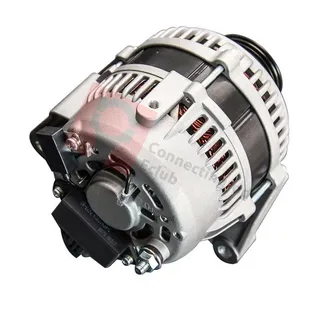If you own a V8 Commodore, then understanding the ins and outs of your alternator is essential for keeping your vehicle running smoothly. The V8 Commodore alternator plays a crucial role in charging your battery and powering the electrical components of your car. In this guide, we will cover everything you need to know about the Commodore alternator, from understanding its functions to troubleshooting and maintenance tips. Let’s start by understanding the primary functions of the alternator, and why it is vital for your Commodore’s performance.
Understanding Your VZ V8 Alternator
The heart of the electrical system in a VZ V8 Commodore, the alternator, plays a pivotal role in ensuring your vehicle’s performance is seamless and efficient. This indispensable component is tasked with the conversion of mechanical energy into electrical energy, a process crucial for both charging the vehicle’s battery and providing power to various electrical systems within the car. Typically situated at the engine’s forefront, the alternator is propelled by a belt connected directly to the engine’s crankshaft, showcasing a perfect blend of mechanical prowess and electrical ingenuity.
In the specific context of the VZ V8 Commodore, understanding the mechanics and functionality of the alternator extends beyond basic car maintenance—it is about safeguarding the vehicle’s longevity and ensuring optimal performance. The alternator is engineered to generate an alternating current (AC), which is then meticulously converted into a direct current (DC). This conversion is paramount as it charges the battery while simultaneously powering the car’s electrical components without a hitch.
Navigating the complexities of the VZ V8 alternator requires a keen understanding of its position and the role it plays within the larger ecosystem of the vehicle’s engine. Recognizing signs of wear or malfunction early can save owners from potential headaches down the road. Given its critical position near the front of the engine, the alternator’s health is directly tied to the vehicle’s overall electrical and mechanical well-being, highlighting the importance of regular checks and maintenance to ensure it operates at peak efficiency.
Understanding these check-up and maintenance routines can save significant time and expense while ensuring your VZ V8 Commodore is running smoothly and efficiently at all times. Therefore, this guide aims to give you a comprehensive overview of the role, care, and troubleshooting of your V8 alternator.
Common Signs of a Failing Commodore Alternator
When the alternator of your V8 Commodore starts to fail, several tell-tale signs can help you catch the problem early. Dim or flickering headlights are one of the first indications, as the alternator’s ability to power the vehicle’s electrical systems wanes. Similarly, if your car’s accessories seem to operate more slowly or less efficiently—such as power windows taking longer to open or close—this could signal an alternator issue.
Another warning sign is if your car’s battery dies unexpectedly. While batteries can fail for various reasons, a malfunctioning alternator failing to recharge the battery properly is a common culprit. Additionally, unusual noises, such as whining or grinding sounds, can originate from the alternator when bearings fail or when internal components become worn or damaged.
Perhaps one of the most straightforward indicators of a problem is the illumination of the dashboard warning light, often shaped like a battery or labelled “ALT” or “GEN,” signalling issues with the charging system. It’s crucial not to ignore these warnings, as they can escalate from minor annoyances to significant problems, potentially leaving you stranded.
It’s also worth noting that these symptoms can sometimes be intermittent, coming and going as the alternator’s condition worsens over time. This sporadic behaviour should not be dismissed, as it typically indicates the alternator is on the verge of failure. Prompt attention to these signs can save you time and money, preventing further damage to your vehicle’s electrical system and ensuring your V8 Commodore remains operational.
Troubleshooting Steps for Your Vy V8 Alternator
Before diving into the alternator itself, ensure your battery is fully charged and in good condition. A weak or dead battery can sometimes mimic alternator problems. Use a multimeter to check the battery voltage; it should be around 12.6 volts when the engine is off.
2. Inspect the Alternator Belt
The alternator belt is crucial for driving the alternator. Check for signs of wear, cracking, or looseness. If the belt is frayed or not properly tensioned, it can affect the alternator’s performance. Adjust or replace the belt if necessary.
3. Examine the Alternator Connections
Ensure all electrical connections to the Vy V8 Alternator are secure. Loose or corroded connections can lead to charging issues. Inspect the wiring for any visible damage or signs of corrosion and clean or repair as needed.
4. Test the Alternator Output
Use a multimeter to measure the alternator’s output voltage. With the engine running, it should read between 13.8 to 14.4 volts. If the voltage is significantly lower or higher, the alternator may be faulty and need replacement.
5. Check for Warning Lights
Pay attention to any dashboard warning lights, such as the battery or charging system light. These indicators can provide clues about alternator issues. If the light is on, it often suggests a problem with the alternator or charging system.
Replacing the Commodore Alternator
Embarking on the journey to replace the alternator in your V8 Commodore can be a fulfilling DIY project with the right preparation. First and foremost, safety is paramount; ensure the car’s battery is fully disconnected to eliminate any risk of electric shock. With the power safely off, the next step involves loosening the tension on the alternator belt. This may require a specific tool depending on your model, so having a comprehensive set of tools at your disposal is beneficial.
Once the belt is removed, the focus shifts to the alternator itself. Various components and possibly electrical connectors will need to be detached to free the alternator from its mount. It’s crucial during this phase to keep track of all screws, bolts, and brackets, organizing them in a way that will simplify the reassembly process.
With the old alternator removed, comparing it to the new one before installation is a good practice. This comparison ensures that the new alternator matches the specifications required for your V8 Commodore. The installation process is essentially the reverse of removal. Carefully place the new alternator into position, reattach any electrical connectors, and secure it with the previously removed bolts and brackets.
Reattaching the alternator belt correctly is the final critical step. The belt must be tensioned appropriately to prevent slipping while not being so tight as to cause premature wear. Once everything is securely in place, reconnect the battery, and start the engine to test the new alternator’s performance. A successful replacement will restore the electrical system’s integrity, ensuring your V8 Commodore continues to operate at its best.
Maintenance Tips for Your LS1 Alternator
The alternator, a critical component of your vehicle’s electrical system, ensures that your battery remains charged and your vehicle’s electrical systems function properly. Regular maintenance is essential to keep it running smoothly and prevent unexpected issues. Here are some key tips to maintain your alternator effectively.
Regular Inspections
Inspect your alternator regularly for any signs of wear and tear. Look for issues such as frayed or damaged wiring, loose connections, and signs of corrosion on the terminals. Early detection of these problems can prevent more significant issues down the line.
Keep It Clean
Dirt and debris can accumulate around your LS1 Alternator, affecting its performance. Periodically clean the area around the alternator to ensure optimal airflow and prevent overheating. Use a dry cloth to wipe away any dirt or grime. Avoid using water or harsh chemicals that could damage electrical components.
Check the Belt Tension
The alternator belt should be properly tensioned. A loose or worn-out belt can lead to poor alternator performance and potential damage. Check the belt tension regularly and adjust or replace it if necessary. A properly tensioned belt will also extend the life of your alternator.
Monitor Electrical Performance
Pay attention to the performance of your vehicle’s electrical systems. Dim lights, erratic gauges, or other electrical issues can indicate a problem with the alternator. Address any such symptoms promptly to avoid further damage.
Choosing the Right Alternator for Your V8 Commodore
Selecting an appropriate alternator for your V8 Commodore is more than just matching the part to your car’s make and model—it’s about ensuring your vehicle operates with maximum efficiency and reliability. The right alternator not only matches your Commodore in terms of compatibility but also meets, or ideally exceeds, the manufacturer’s specifications to support all of your vehicle’s electrical needs.
Begin by identifying the specific requirements of your vehicle, including the model year and engine type, as these details directly influence the alternator’s compatibility. Your V8 Commodore may benefit from an alternator that can handle additional electrical load if you’ve added aftermarket accessories or performance parts that demand more power than the stock electrical system was designed to manage.
Quality cannot be overstated when selecting an alternator. Opt for alternators from well-regarded manufacturers known for their durability and performance under demanding conditions. A higher-quality alternator may come with a higher price tag, but the investment often pays off in terms of longer service life and fewer issues over time.
Also, take into account the warranty offered with the alternator. A substantial warranty period is a testament to the manufacturer’s confidence in their product’s reliability and durability. Additionally, ensure the return policy is straightforward, offering peace of mind should you encounter any issues post-installation.
Finally, while compatibility and quality are paramount, consider the ease of installation and whether the alternator requires any modifications to fit your V8 Commodore. In some cases, it may be worth consulting with a professional to confirm the best choice for your vehicle, ensuring that the alternator you select enhances your driving experience without introducing unforeseen complications.
Conclusion
Wrapping up, the health and functionality of your V8 Commodore alternator are indispensable to the overall well-being of your vehicle. A deeper insight into how it operates, potential signs of failure, and the importance of regular maintenance empowers you to take proactive steps in preserving your car’s electrical integrity. Addressing alternator issues promptly and understanding when professional advice is needed can significantly reduce the risk of unexpected breakdowns and prolong the lifespan of your V8 Commodore.
FAQS
Q: What are the indicators that my V8 Commodore alternator might be failing?
A: Pay attention to early warning signs like dim or flickering headlights, accessories operating slower than usual, unexpected battery failure, unusual noises such as whining or grinding from the alternator, and the dashboard warning light shaped like a battery or labeled “ALT” or “GEN.” These symptoms suggest the V8 Commodore alternator may not be charging the battery adequately or is nearing the end of its service life.
Q: Is it feasible for me to replace the alternator on my V8 Commodore by myself?
A: Replacing the failing alternator can be a complex task, depending on your mechanical skill level. If you’re comfortable with car maintenance tasks and have the necessary tools, you could undertake this project. However, for safety and assurance, it’s often best to seek the expertise of a professional mechanic. They can ensure the replacement is executed correctly, avoiding any potential risks or damage to your vehicle’s electrical system.
Q: How frequently should the alternator in my V8 Commodore be checked?
A: Regular inspection of the alternator is crucial for maintaining your vehicle’s performance and preventing unexpected issues. An annual check-up by a professional is advisable, or sooner if you encounter any of the warning signs mentioned above. These checks can help identify any potential problems early on, potentially saving you from more significant, costly issues down the line. Remember, maintaining the alternator’s health is key to the reliability and longevity of your V8 Commodore’s electrical system and overall performance.
| Related Business Listings |
| Contact Directory |
| Local Business Profiles |




